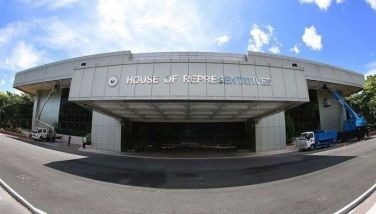‘Genetically enhanced’ tilapia: Larger, tastier, quicker to grow
March 12, 2003 | 12:00am
CASTILLEJOS, Zambales — The shift from Tita Cory’s galunggong (scad) to Ate Glo’s tilapia would be virtually declared today as the Bureau of Fisheries and Aquatic Resources (BFAR) launches here a genetically improved tilapia variety found to be "larger, tastier and quicker to grow."
No, the new variety is not to be called GMA tilapia. According to BFAR officials, it has been named "GET EXCEL," which stands for "genetically enhanced tilapia excellent strain."
In a statement, BFAR director Malcolm Sar—miento said GET EXCEL is a "product of genetic enhancement and cross-breeding" undertaken at BFAR research centers in the Science City of Muñoz in Nueva Ecija.
"The new breed has the edge compared to other species (because of) its excellent performance, being larger, tastier and quicker to grow," he said.
Earlier, Presidential Adviser for North Luzon Renato Diaz said President Arroyo wanted to leave her mark on the Filipino table before she steps down from the presidency in 2004 by seeing to it that tilapia, also known as St. Peter’s fish, would be more affordable to the poorest Filipino families and would remain so even long after her term.
The galunggong has ceased to be the poor man’s viand. In Central Luzon, it now sells for P70 to P80 a kilo, while tilapia can be bought for P60 per kilo.
Diaz said the President has been meeting with agriculture and fishery officials since last December to tackle ways to further boost aquaculture nationwide by encouraging rice farmers to alternate crops with tilapia culture, thus boosting its supply and lowering its cost.
BFAR spokesman Ed Paez said the new tilapia variety will be formally launched today at the Magsaysay Memorial Fish Nursery in Barangay Looc here.
Attending the launch are Sarmiento, Zambales Gov. Vicente Magsaysay, BFAR regional director Remedios Ontangco, Castillejos Mayor Enrique Magsaysay and leaders of local fisherfolk.
Sarmiento said the current aquaculture production in Central Luzon "could be doubled or even tripled because of the new variety’s shorter culture period that would allow at least four harvests per year."
He said it is fitting that GET EXCEL is launched in Central Luzon which, he noted, is the known "tilapia capital of the Philippines."
Dr. Melchor Tayamen, chief of the BFAR National Freshwater Fisheries Technology Center and the developer of GET EXCEL, said the new variety "was proven to be 38 percent better than the existing tilapia strains in the market in terms of taste, yield and growth."
Paez said GET EXCEL has passed the scrutiny of the scientific community and was pretested in different water environments such as fishcages, fishponds and other communal waters.
According to a BFAR report, the new tilapia variety is 38.12 grams heavier for every 100 grams of the old varieties, thus resulting in "increased fish production and gross revenue for fish farmers."
It added that the "cost of production per kilo can be substantially reduced by raising the new variety, thus providing a cheap source of affordable animal protein for rural and urban consumers."
BFAR records show that the Philippines has a vast natural resource of 106,328 hectares of freshwater and 232,065 hectares of brackishwater swamplands, as well as 14,531 hectares of freshwater and 239,000 hectares of brackishwater fishponds.
"President Arroyo wants tilapia readily within reach of the poorest of the poor in line with her policy of bringing food to the tables of Filipino families," Diaz said.
"This is why the government is now encouraging better land use through multi-cropping and aquaculture," he said.
He said galunggong is becoming harder to catch from the sea, while tilapia can merely be raised even in ricefarms after harvests.
No, the new variety is not to be called GMA tilapia. According to BFAR officials, it has been named "GET EXCEL," which stands for "genetically enhanced tilapia excellent strain."
In a statement, BFAR director Malcolm Sar—miento said GET EXCEL is a "product of genetic enhancement and cross-breeding" undertaken at BFAR research centers in the Science City of Muñoz in Nueva Ecija.
"The new breed has the edge compared to other species (because of) its excellent performance, being larger, tastier and quicker to grow," he said.
Earlier, Presidential Adviser for North Luzon Renato Diaz said President Arroyo wanted to leave her mark on the Filipino table before she steps down from the presidency in 2004 by seeing to it that tilapia, also known as St. Peter’s fish, would be more affordable to the poorest Filipino families and would remain so even long after her term.
The galunggong has ceased to be the poor man’s viand. In Central Luzon, it now sells for P70 to P80 a kilo, while tilapia can be bought for P60 per kilo.
Diaz said the President has been meeting with agriculture and fishery officials since last December to tackle ways to further boost aquaculture nationwide by encouraging rice farmers to alternate crops with tilapia culture, thus boosting its supply and lowering its cost.
BFAR spokesman Ed Paez said the new tilapia variety will be formally launched today at the Magsaysay Memorial Fish Nursery in Barangay Looc here.
Attending the launch are Sarmiento, Zambales Gov. Vicente Magsaysay, BFAR regional director Remedios Ontangco, Castillejos Mayor Enrique Magsaysay and leaders of local fisherfolk.
Sarmiento said the current aquaculture production in Central Luzon "could be doubled or even tripled because of the new variety’s shorter culture period that would allow at least four harvests per year."
He said it is fitting that GET EXCEL is launched in Central Luzon which, he noted, is the known "tilapia capital of the Philippines."
Dr. Melchor Tayamen, chief of the BFAR National Freshwater Fisheries Technology Center and the developer of GET EXCEL, said the new variety "was proven to be 38 percent better than the existing tilapia strains in the market in terms of taste, yield and growth."
Paez said GET EXCEL has passed the scrutiny of the scientific community and was pretested in different water environments such as fishcages, fishponds and other communal waters.
According to a BFAR report, the new tilapia variety is 38.12 grams heavier for every 100 grams of the old varieties, thus resulting in "increased fish production and gross revenue for fish farmers."
It added that the "cost of production per kilo can be substantially reduced by raising the new variety, thus providing a cheap source of affordable animal protein for rural and urban consumers."
BFAR records show that the Philippines has a vast natural resource of 106,328 hectares of freshwater and 232,065 hectares of brackishwater swamplands, as well as 14,531 hectares of freshwater and 239,000 hectares of brackishwater fishponds.
"President Arroyo wants tilapia readily within reach of the poorest of the poor in line with her policy of bringing food to the tables of Filipino families," Diaz said.
"This is why the government is now encouraging better land use through multi-cropping and aquaculture," he said.
He said galunggong is becoming harder to catch from the sea, while tilapia can merely be raised even in ricefarms after harvests.
BrandSpace Articles
<
>
- Latest
- Trending
Trending
Latest
Trending
Latest
Recommended
































